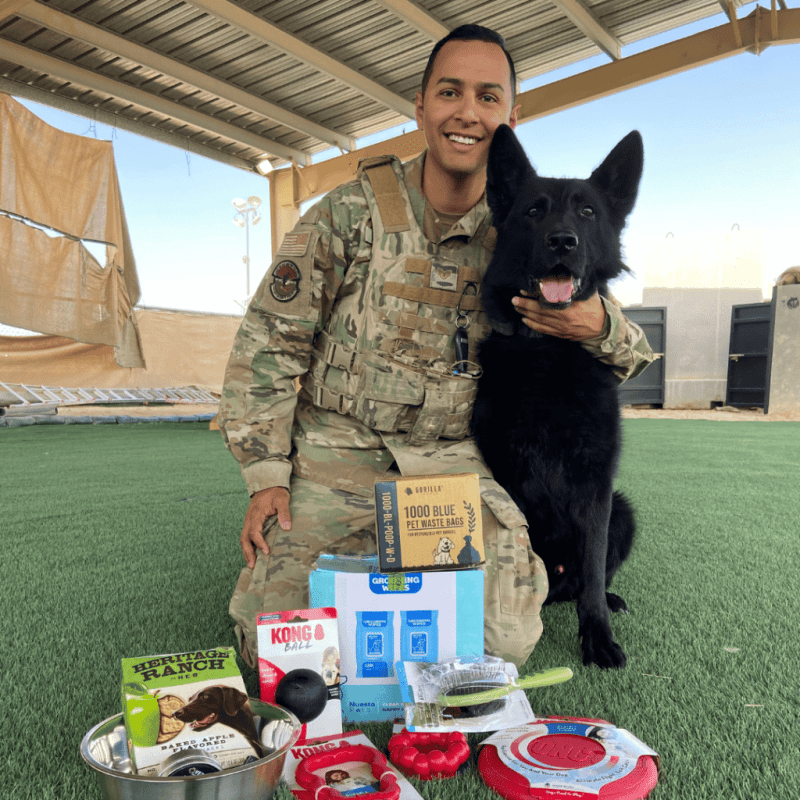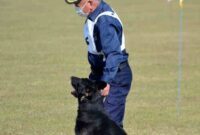Military Working Dogs – A shortage of military working dogs threatens national security, says a recent report from the US Naval Post Graduate School. The navy is on alert.
“Although working dogs are not an official part of the current defense industry, the low domestic production capacity of working dogs threatens the government’s ability to provide national security,” the researchers wrote in the report. “Approximately 90% of today’s working dogs were bred overseas.”
Military Working Dogs
Military working dogs are usually one of four breeds: German Shepherd, Belgian Malinois, Dutch Shepherd, or Labrador Retriever. Many are imported from Europe.
Military Working Dogs: Guardians Of The Night
US Army Spc. David Sheriff of the 1st Battalion, 5th Infantry Regiment, 1st Brigade Combat Team, 25th Infantry Division, plays with a military working dog, Ddagmar, at Al Asad Air Base, Iraq, May 29, 2020. (Credit: US Army/Cover Images )
“A lot of our science and technology over the years has been trying to imitate the work of these dogs. Their olfactory glands are 10,000 times more sensitive than any equipment we’ve ever built. So the detection work they do, a dog that finds explosives or drugs, can never be replaced.” , said Maj. Matthew Kowalski, commander of the 341st Training Squadron at Joint Base San Antonio, according to the report.
The lack of domestically bred military working dogs has been a problem for decades because breeders in the US have it easier and more profitable. for showing dogs and guiding service dogs, the report explained. The researchers recommend that the federal government subsidize new breeding programs in exchange for preferential purchase of working dogs.
American Kennel Club vice president of government relations Sheila Goffe highlighted the issue in an op-ed in the Military Times.
National Military Working Dogs Memorial Collection In Lincoln City Centre
United States Army Sgt. Michael Ramirez fires his M4 carbine with his military working dog by his side at Al Asad Air Base, Iraq, May 8, 2020. (Credit: US Army / Cover Images)
“The Department of Defense maintains a modest breeding program at the prisons at Lackland Air Force Base in San Antonio, which is insufficient to meet domestic demand,” Goff wrote.
“The supply of capable working dogs from foreign sources continues to tighten. The threat of terrorism and the resulting demand for working dogs in Europe and around the world means there is a growing shortage of moderate quality foreign dogs available for US protection.” he continued

Congress approved a defense spending budget of $694.6 billion for fiscal year 2021. Earlier in March, Republicans on the House Armed Services Committee wrote a letter to Biden calling for a 3% to 5% increase in the defense budget next year.
Military Working Dogs Have Food Options Thanks To Subsistence Efforts > Defense Logistics Agency > News Article View
“Years of defense cuts under the Budget Control Act (BCA) have undermined military readiness, set back efforts to modernize the force, and given our adversaries the time they need to make significant gains. An advantage that threatens our military superiority today,” the letter read. Eight GOP lawmakers, led by Rep. Rep. Mike Rogers, R-Ala., read the “Dogs of War” rebuttals here. For the Marvel Comics character, see War Dog (Marvel Comics). For other uses, see Dogs of War and Dogs of War.
A U.S. Air Force Belgian Malinois in an M2A3 Bradley Fighting Vehicle in Kahn Bani Sahd before departing for a mission in Iraq on February 13, 2007.
War dogs have a very long history dating back to ancient times. From combat training, to use as scouts, trackers, messengers, mercy dogs and trackers, their uses are varied and some continue into modern military use.
Among the Greeks and Romans, dogs often served as fighting or patrol dogs, although they were sometimes used in battle.
Foster Families Prepare Working Dogs For Duty > Joint Base San Antonio > News
War dogs were first used in a battle recorded in classical sources by the Lydian Allies against the Cimmerians in BC. around 600 Lydian dogs killed some attackers and attacked others.
At the Battle of Pelusium (525 BC), Cambyses II ordered dogs, cats and other animals considered sacred by the Egyptians. By putting these animals in the forefront, he supposedly got the Egyptians to stop using their projectile weapons.
Breeding gifts of war dogs between European kings were considered appropriate tokens of exchange throughout the Middle Ages. Other civilizations used armored dogs to defend caravans or attack enemies.

In the Far East, XV. The 19th century Vietnamese Emperor Lê Lợi raised a pack of over 100 dogs, taught and trained by Nguyễn Xí, whose skills were impressive enough to be promoted to commander of a shock troop regiment.
Veteran Military Working Dogs Looking For New Homes, Up For Adoption
Later, Frederick the Great of Prussia used dogs as messengers during the Seven Years’ War with Russia. Napoleon also used dogs in his campaigns. Dogs were used until 1770 to guard French naval installations.
Geral Grant recounts how Union troops destroyed clusters of Southern bloodlines wherever they were found because they had been trained to hunt runaway slaves before the war.
Dogs have been used in warfare by many civilizations. As the war progressed, their goals changed dramatically.
Dogs are used for many purposes. Different breeds were used for different tasks, but they always met the demands of the handlers. Many of the roles of war dogs are outdated and obsolete, but the concept of the war dog lives on in modern warfare.
Shortage Of Military Working Dogs A National Security Risk, Report Warns
In ancient times, dogs, usually large mastiff-type breeds, wore armor or spiked collars and went into battle to attack in desperation. This strategy was used by various civilizations, such as the Romans and Greeks. Although not as common as in previous centuries, modern militaries continue to use dogs as attack dogs. US Army SOCOM forces still use dogs during raids to catch fugitives or prisoners, or to search areas too difficult or dangerous for human soldiers (such as crawl spaces).
Another program tested during World War II was proposed by a Swiss citizen living in Santa Fe, New Mexico. William A. Presre suggested using large dogs to kill Japanese soldiers. He convinced the military to lease an island in the Mississippi for training facilities. There, the army hopes to train up to two million dogs. The idea was to launch assaults on the island with landing craft that would unleash thousands of dogs on the Japanese defenders, and then the troops would scatter the Japanese defenders in confusion. One of the biggest problems encountered was finding Japanese soldiers to train the dogs, as very few Japanese soldiers were captured. Finally, Japanese-American soldiers volunteered to train. Another big problem is with dogs; either they were too docile, didn’t respond well to beach-crossing training, or they were afraid of fire. After millions of dollars were raised with inconclusive results, the program was abandoned.
The Soviet Union used dogs for anti-tank purposes beginning in the 1930s. Early anti-tank dogs were equipped with bent rod mines and trained to operate beath emy tanks, which would automatically detonate the mines. However, the dogs were trained in stationary Russian tanks and rarely walked under moving tanks; instead, he was shot as he ran past the moving tanks. If the Russian and German tanks are ready, the dogs prefer to run to the familiar Russian tanks.

At the outbreak of World War I, many European communities used dogs to pull small carts for milk and similar purposes.
Military Working Dogs U.s. Postage Stamps Sheet Of 20 Forever Postage Stamps Scott 4508b
In August 1914, the Belgian Army used dogs to pull Maxim guns on wheeled wagons and supplies, or were wounded in their wagons.
Two dogs of the strong and docile Martin Belge breed were used to pull each machine gun or bullet. Common in civilian use and cheap to buy and feed, dogs were tougher and more suitable for firefighting than pack horses.
Dogs were officially withdrawn from military use in December 1916, although horse-drawn carts and motorized vehicles completely replaced them a few months later.
Frch had 250 dogs at the beginning of the First World War. The Dutch army copied the idea and had hundreds of dogs trained and ready by the end of World War I (the Netherlands remained neutral). The Soviet Red Army also used dogs to carry wounded m aid stations during World War II.
K 9 Units And Military Working Dogs
Dogs were often used to carry messages in battle. They are comfortable moving to a second manager. This requires a dog that is very loyal to both masters, otherwise the dog will not deliver the message on time or at all. Some messenger dogs also performed other communication tasks, such as pulling telephone lines or cables from one place to another.
A 2 kilogram (4 lb) Yorkshire terrier named Smoky was used to run the 10 to 20 cm (4–8 in) diameter and 21 m (70 ft) long telegraph wire. . ) pipe in assured communication without moving troops in the line of fire.
Dogs are often used as pets for military units. The dog in question may be an officer’s dog, an animal selected for adoption by the unit, or one of its dogs serving as a working dog. Some sea dogs like Sinbad and Judy are members of the service. Some units chose to use a particular breed of dog as their standard pet, with new dogs replacing old or dead ones.

Adopt military working dogs, military working dogs breeds, military working, military working dogs equipment, military working dogs afghanistan, working military dogs, books on military working dogs, military working dogs history, military working dogs memorial, military working dogs national monument, retired military working dogs, support military working dogs
- Search Rescue Dogs - July 29, 2024
- Police Dog Training - July 25, 2024
- Pointing Dog Training - July 25, 2024




